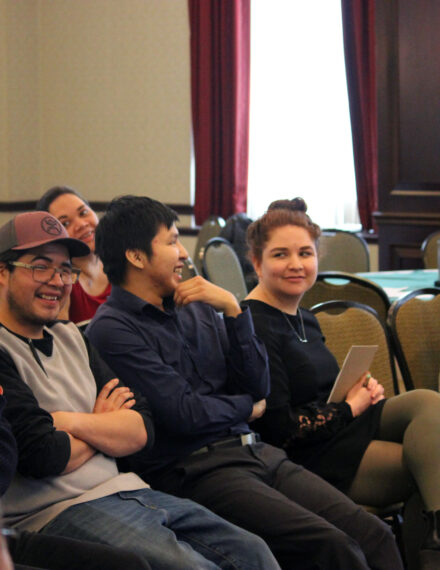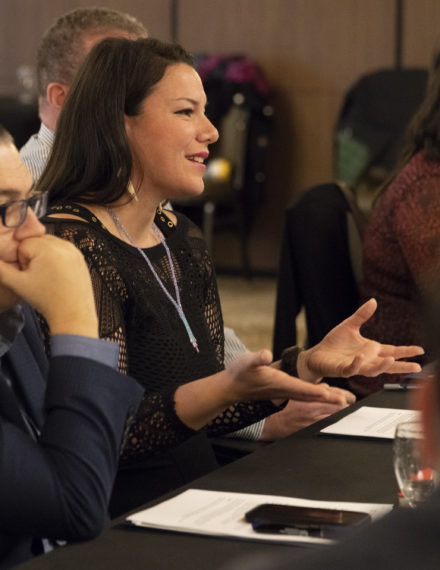
Starting December 2018, Alternatives Journal published an eight-part series on the 2015-2017 Jane Glassco Northern Fellows policy papers, which address some of the most pressing issues facing the North. This blog was originally published on December 3, 2018 at https://www.alternativesjournal.ca/community/blogs/aj-special-delivery/recruiting-indigenous-physicians-northwest-territories
In 2017, there was a 35 per cent shortage of general practitioner physicians in the Northwest Territories (NWT)[i]. This shortage has led to the fact that nearly half of the territory’s population lacks regular access to a medical doctor[ii]. Remote Indigenous communities are disproportionately impacted.
Unlike other small Canadian jurisdictions – such as the Yukon or Prince Edward Island – the NWT does not have programs encouraging students to study medicine elsewhere before returning home to practice. Instead, remote communities in the NWT depend on solutions such as hiring locum physicians (temporary, travelling doctors) or telephone-medicine.
A policy paper from Thomsen D’Hont, a recent alumni of the Jane Glassco Fellowship Program, asks what programming could exist in the NWT that would train and recruit Indigenous doctors? The paper challenges the Territorial government to take bold steps to address the current crisis.
The NWT population is among the youngest in Canada. Among that population, a new generation of aspiring doctors is eager to practice medicine.
D’Hont is one of them. He is a Metis medical student from Yellowknife studying at the University of British Columbia’s Northern Medical Program in Prince George, BC. He plans to return home to practice after graduating.
His paper, “Addressing the Need for Indigenous Physicians in the Northwest Territories,” combines personal experience with detailed policy analysis and research.
While D’Hont was working on his paper, only one Indigenous doctor was working in the NWT despite the fact that half of the NWT is Indigenous. The 1996 Royal Commission on Aboriginal Peoples report and the 2015 Truth and Reconciliation Commission’s Calls to Action recommend training and hiring more Indigenous healthcare workers.
In his paper, D’Hont identified 12 cost-effective and easy to implement policy solutions which would encourage more Indigenous youth to practice medicine in the NWT.
From 2006-2011, the NWT guaranteed Indigenous students the opportunity to study medicine. The Territorial government partnered with the universities of Alberta and Calgary to reserve spaces within their medical programs for qualified applicants.
The Yukon runs a similar partnership with Memorial University in Newfoundland. Restoring this NWT program would ensure that qualified, Indigenous students from the territory receive the opportunity to study medicine.
British Columbia boosts Indigenous medical enrolment by running workshops to help students prepare their applications and their admission tests. D’Hont recommends the NWT takes a similar approach.
NWT medical students also need expanded financial support. The current financial assistance model currently focuses on undergraduate studies by providing 12 semester of grants, beyond which students are no longer available for grants and must rely on loans. This increases the financial burden on aspiring doctors.
Both the NWT and the Yukon operat a “return-for-service” incentive which turns student loans into grants for doctors who practice medicine in the North. D’Hont recommends that the NWT synchronize the values rewarded within their program with those offered in the Yukon.
Most importantly, young people need to be inspired to go to medical school. Having just one Indigenous doctor in a territory twice the size of Texas means that students lack role models within the profession.
D’Hont recommends creating meaningful actions for doctors and students of all ages including: physician shadowing; clinical rotations in the NWT for Indigenous medical trainees; targeted high-school outreach and; establishing a territorial family residency.
“Implementing any selection of [these] options will make a difference for aspiring doctors in the NWT,” D’Hont writes.
To read Thomsen D’Hont’s policy paper – including all 12 of his recommendations with detailed costing and timelines – as well as other policy work from the Jane Glassco Northern Fellows, please visit www.GordonFoundation.ca/resources/fellowship.
The Gordon Foundation is a charitable organization dedicated to protecting Canada’s water and empowering Canada’s North. The Jane Glassco Northern Fellowship is a crucial part of our mission to promote innovate public polices for the North and amplify Northern voices.
Breaking Down Colonial Barriers Through Education (Mar 4, 2019)
Transforming Nunavut’s Criminal Justice System (Feb 25, 2019)
Nunavut Land Claims Agreement and Arctic Governance (Feb 11, 2019)
Waste Management And the Circular Economy of the North (Feb 4, 2019)
Keeping Aboriginal Youth out of the Correctional System (Dec 10, 2018)
Encouraging Closer Collaboration Between Scientists & Yukon First Nations (Dec 7, 2018)
Recruiting Indigenous Physicians in the NWT (Dec 3, 2018)
Highlighting Policy Proposals from the Jane Glassco Northern Fellowship Program (Nov 30, 2018)
[i] D’Hont, Thomsen, “Addressing The Need for Indigenous Physicians in the Northwest Territories,” Jane Glassco Northern Fellowship 2015-2017 Policy Recommendations (2018): p.56
[ii] Giles, Sarah, “The North Needs More Doctors,” The Walrus (Nov. 22 2017): https://thewalrus.ca/the-north-needs-more-doctors/


